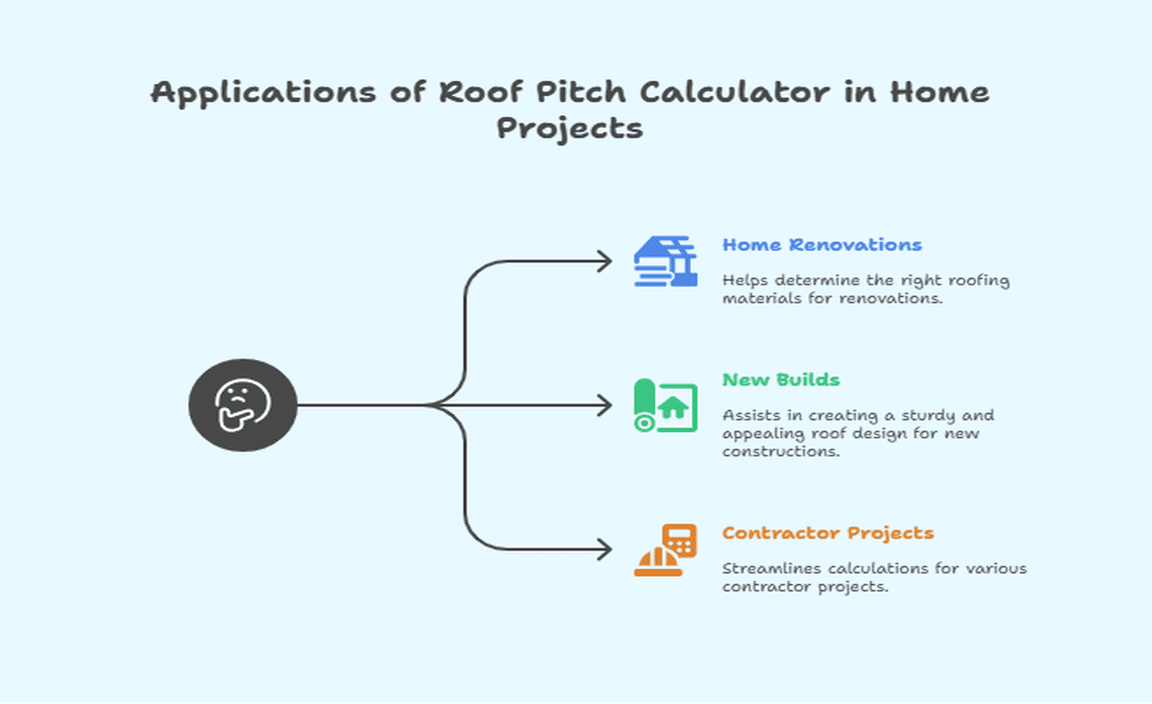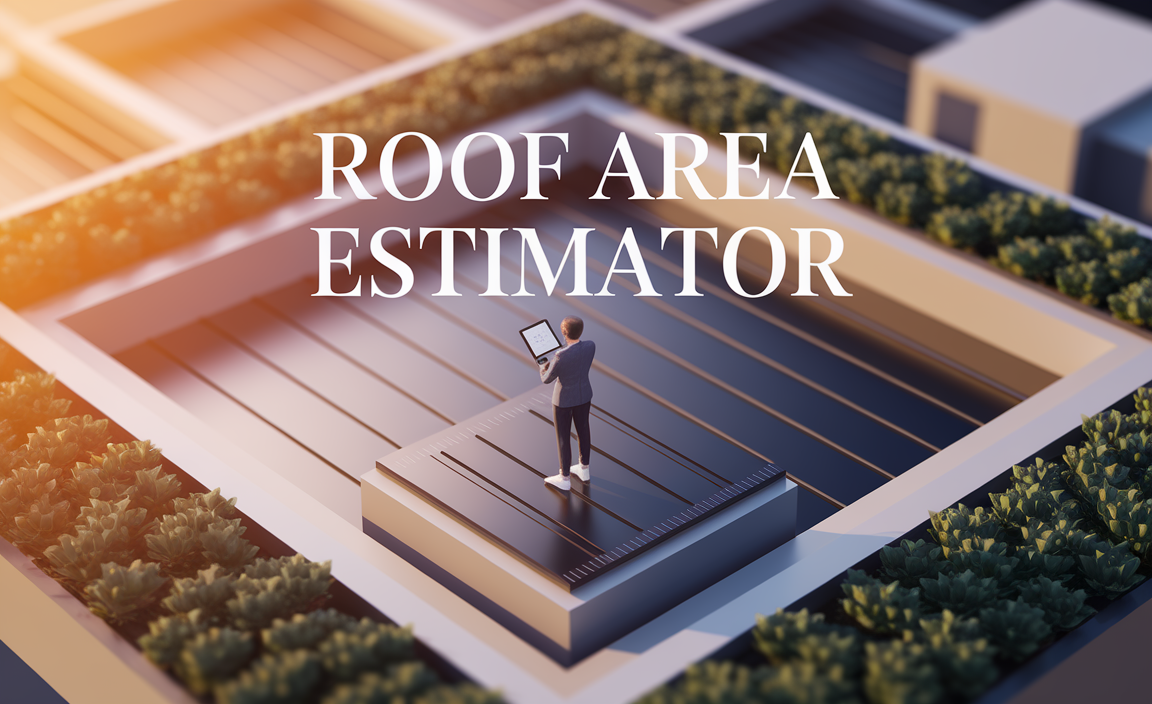Have you ever looked at a roof and wondered how steep it really is? Understanding roof pitch is important for building and home improvement. A roof pitch calculator can help you figure that out easily!
Knowing your roof’s pitch helps you choose the right materials and plan for water drainage. It can even affect how good your house looks! Imagine designing your dream home, only to discover your roof pitch is too steep or too flat.
Did you know that a roof’s pitch can change how much snow it can hold? That’s right! A steeper roof will shed snow easily, while a flatter one might struggle. So, how can you find the perfect pitch for your roof?
With our handy roof pitch calculator, you can do just that! Let’s dive in and explore how easy it is to make your roofing decisions smarter and safer!

Table of Contents
Roof Pitch Calculator: Simplify Your Roofing Projects

Using a Roof Pitch Calculator is simple and helpful. It lets you figure out the angle and steepness of a roof easily. Why is this important? A good roof pitch can help with drainage and snow load. This tool can save you time and money when planning your roofing project. You might be surprised at how even a small change in pitch can affect your home’s look and safety. Are you ready to see your roof’s potential?
Understanding Roof Pitch
Definition of roof pitch and its significance in construction. Common measuring units for roof pitch (degrees, rise/run).
Roof pitch is a way to describe how steep a roof is. It is important because the slope affects how well the roof sheds water and stands up to weather. A steeper roof can handle snow better, while a gentler slope is easier to walk on. Roof pitch can be measured in two common ways:
- Degrees: The angle of the roof slope.
- Rise/Run: The height of the roof rise compared to its horizontal run.
Understanding roof pitch helps builders design safer and more effective homes.
What is roof pitch?
Roof pitch is the angle at which the roof rises. It is measured as the height (rise) over the distance (run) across.
Importance of Calculating Roof Pitch

Impact on roofing materials and design choices. Influences on water drainage and building durability.
Knowing how to calculate roof pitch is very important. The roof’s angle affects the choice of materials you can use. A steep roof may need different materials than a flat one. Roof pitch also plays a big role in how water drains off. Good drainage helps the building last longer. If water sits on the roof, it can cause damage. This can lead to costly repairs. Choose your roof pitch wisely to ensure safety and durability.
Why is roof pitch important?
Roof pitch affects many aspects of a building. It impacts:
- Material choices: Different pitches work better with specific materials.
- Water drainage: Steeper roofs drain better, preventing water damage.
- Building durability: Correct pitch helps your roof last longer.
How to Measure Roof Pitch Manually
Stepbystep guide to measuring pitch with a level. Tools required for manual measurement.
Measuring roof pitch can be fun, like a mini-adventure on your roof! First, you’ll need a level, a measuring tape, and a pencil. Here’s a simple step-by-step guide:
| Step | Action |
|---|---|
| 1 | Place the level on the roof. |
| 2 | Make sure the bubble is centered. |
| 3 | Measure how far the level goes up the roof. |
| 4 | Multiply this height by 12 for the pitch. |
And there you go! You’ve got your roof pitch! Remember, a roof that’s too steep might just try to slide you off during a storm—not cool!
Step-by-Step Instructions for Using an Online Roof Pitch Calculator

Detailed guidance on inputting data. Examples of calculations for different roof designs.
Using an online roof pitch calculator is simple! First, find the calculator on a website. Then, enter the roof’s rise (height) and run (length) using feet or inches. Click calculate to see the pitch.
For example:
- A roof that rises 4 feet over 12 feet will have a pitch of 4:12.
- A roof that rises 9 inches over 3 feet will have a pitch of 9:36.
This calculator helps you choose the right materials and designs. It’s quick and easy to use!
How do I measure roof pitch?
To measure roof pitch, divide the rise by the run. This shows how steep the roof is. Use a level and measuring tape for accurate results.
Applications of Roof Pitch Calculator in Home Projects

Use cases for homeowners and contractors. How it assists in renovations and new builds.
A roof pitch calculator is a handy tool for homeowners and contractors alike. It helps in figuring out the angle of your roof without having to guess, which is good, unless you enjoy surprise leaks! Once you have the roof pitch, planning renovations or new builds becomes a breeze. Just remember, the steeper the pitch, the more fun it is to shove snow off your roof! Here’s how it can help:
| Use Cases | Application |
|---|---|
| Home Renovations | Determining the right materials for roofing |
| New Builds | Creating a sturdy and appealing roof design |
| Contractor Projects | Streamlining calculations for projects |
Using a roof pitch calculator makes every building project safer and smarter. Plus, less time measuring means more time for snacks. And who doesn’t love snacks?
Comparing Roof Pitch Calculators: Features and User Experience
Comparison of popular online and appbased calculators. User reviews and feedback on ease of use.
Many people use roof pitch calculators to find the right angle for their roofs. There are many options online and as apps. Each has different features and user experiences. Here are some popular tools:
- User-Friendly Design: Easy for anyone to use.
- Detailed Calculations: Offers accurate pitch results.
- Design Features: Includes graphics for better understanding.
Users often share their thoughts. Many appreciate quick results and clear instructions. **User reviews** frequently highlight how simple these tools are, making roof planning less of a chore. Feedback suggests that the best calculators combine functionality with ease of use.
Which roof pitch calculator is the best?
The best roof pitch calculator varies by user needs. Some prefer online options for quick access, while others like apps for convenience. Find what works best for you!
Finding the Right Roof Pitch for Your Home
Factors to consider when selecting pitch (climate, aesthetics). Recommendations for different architectural styles.
Choosing the right roof pitch for your home is important. Many factors can affect your decision. Think about your climate. If you have heavy snow, a steep roof works better to shed it off. For hot places, a lower pitch helps cool the house. Aesthetics also matter. A modern home might look best with a flat roof, while a classic style suits a steep pitch. Here are some suggestions:
- Traditional homes: Steep roof (45 degrees)
- Modern homes: Low pitch (10-20 degrees)
- Cottages: Moderate pitch (30 degrees)
Consider all these details to find the best fit for your home!
What factors affect roof pitch selection?
Climate and building style are key factors. Snowy areas need steep roofs. Hot climates benefit from lower slopes. Choose a pitch that matches your home’s look and local weather.
Future Trends in Roof Pitch Calculation Technology

Advancements in software and tools for construction. The role of AI and machine learning in roof design calculation.
New technology is changing how we calculate roof pitch. Advanced software makes it easier for builders to do their jobs. With these tools, we can plan roofs quickly and accurately. AI and machine learning are adding even more benefits. They help predict the best roof design by using data from past projects. This saves time and reduces mistakes. Builders will soon have powerful tools that make their work faster and better.
What is the role of AI in roof design?
AI analyzes patterns in construction data to improve designs. It learns from past projects to suggest the best roof styles.
Benefits of AI in roof design:
- Faster calculations
- More accurate designs
- Reduced costs
- Better safety measures
Conclusion
In conclusion, a Roof Pitch Calculator helps you find the angle of your roof easily. It’s important for building and repairing roofs safely. You can use online tools or apps for quick calculations. Try using one today for your next project, or explore more tips on roofing. Remember, knowing the pitch can make your work better and safer!
FAQs
What Is Roof Pitch, And How Is It Defined In Terms Of Slope And Angle?
Roof pitch is how steep the roof is. We usually describe it as a ratio, like 4:12. This means for every 12 inches you go sideways, the roof rises 4 inches. You can also think of roof pitch as an angle. A steeper angle means a higher roof.
How Can I Calculate The Roof Pitch Of An Existing Roof Without Professional Help?
To find the roof pitch, you can use a level and a tape measure. First, place the level flat across the roof. Then, measure straight down from the end of the level to the roof. This number is called the “rise.” Next, measure how long the level is. This is the “run.” The pitch is the rise over the run. For example, if the rise is 4 inches and the run is 12 inches, the pitch is 4:12.
What Tools Are Necessary For Measuring Roof Pitch Accurately?
To measure roof pitch accurately, you need some simple tools. First, get a level, which helps you find flat surfaces. Then, use a tape measure to check distances. A protractor can show angles clearly. Finally, a marking pencil helps you mark measurements on the roof. With these tools, you can easily measure roof pitch!
What Factors Should Be Considered When Determining The Ideal Roof Pitch For A New Construction Project?
When choosing the best roof pitch, think about how much rain or snow your area gets. Steeper roofs help water and snow slide off easily. You should also consider the style of your house. Some designs look better with certain pitches. Finally, check local building rules, as they may have specific ideas about roof pitch.
How Does Roof Pitch Affect Water Drainage And Overall Roof Performance?
The roof pitch is how steep or flat the roof is. A steeper roof helps water slide off quickly. This keeps water from pooling, which can cause leaks and damage. A flat roof collects more water, which can be bad if it doesn’t drain well. So, a good pitch helps the roof work better and last longer.
Resource:
-
Roof Load and Snow Considerations: https://www.energy.gov/energysaver/design/roofs
-
Slope Measurement Basics in Construction: https://www.engineeringtoolbox.com/roof-slope-d_1306.html
-
How AI is Changing Architecture: https://www.architectmagazine.com/technology/ai-in-architecture_o
-
Choosing Roofing Materials Based on Climate: https://www.houselogic.com/by-room/exterior/roofing-materials/






